The Golden Dawn or Thoth Method

Difficulty: Complicated
Note: Decks that use reversed cards such as the Rider-Waite do not work well with this spread, which was designed to be read using elemental dignities.
The Golden Dawn spread is best suited for use with the bifrost Tarot and especially the Book of Thoth, as these decks are meant to be read a certain way with the Court cards. Princes and Queens represent actual men and women connected with the matter, while Princesses generally represent ideas; thoughts or opinions, and Knights represent arrival or departure of a matter depending on the direction faced.
In this spread, particular attention should be payed to a card’s exact position in relation to its neighbors. Whether the neighbor cards bear the same energy (suit) determines whether a card is considered well- or ill-dignified. Opposite suits ill-dignify each other, while other suits are considered friendly. Cards of the same suit strengthen each other.
As with other spreads, it is important to count the cards’ tendencies, such as whether there is a lot of one particular suit or number pattern. The patterns will reveal special messages. Lots of Majors indicates higher forces at work, lots of cups suggest strong emotions, etc.
Card #1 represents the querent and the nature of the topic at hand.
Cards #2 & #3 are used in conjunction with #1 to further comprehend the nature of the topic.
Your Golden Dawn Reading with the Thoth Tarot
| The Alternate Path (or Extension of Current Path) |
Your Current Path |
|||||
3 of Wands |
9 of Swords |
2 of Swords |
3 of Swords |
6 of Disks |
Knight of Cups |
|
| The Querent | ||||||
The Tower |
9 of Wands |
Adjustment |
||||
| The Psychological Basis | Karma | |||||
The Moon |
Princess of Swords |
4 of Swords |
Ace of Cups |
Art |
The Aeon |
|
This spread is set up to read a certain way with the Court cards. Princes and Queens represent actual men and women connected with the matter, while Princesses generally represent ideas; thoughts or opinions, and Knights represent arrival or departure of a matter depending on the direction faced.
In this spread particular attention should be payed to a card's exact position in relation to its neighbors. Whether the neighbor cards bear the same energy (suit) determines whether a card is considered well- or ill-dignified. Opposite suits ill-dignify each other, while other suits are considered friendly. Cards of the same suit strengthen each other.
Also it is important to count the cards' tendencies, such as whether there is a lot of one particular suit or number pattern. Patterns reveal special messages. Lots of trumps means higher forces at work, lots of cups means strong emotions, etc.
The Querent
cards represent the querent and the nature of the topic at hand. The first card (in the center of the spread) represents the very core of the matter, and the other two cards around it are added to it in order to further comprehend the nature of the topic.
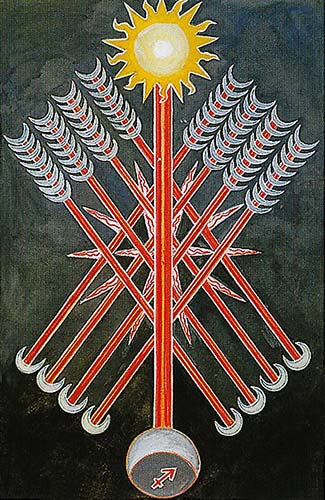
Moon in Sagittarius – Strength
This card is referred to Yesod, the Foundation; this brings the Energy back into balance. The Nine represents always the fullest development of the Force in its relation with the Forces above it. The Nine may be considered as the best that can be obtained from the type involved, regarded from a practical and material standpoint. This card is also governed by the Moon in Sagittarius; so here is a double influence of the Moon on the Tree of Life. Hence the aphorism 'Change is Stability'.
The Wands have now become arrows. There are eight of them in the background, and in front of them one master arrow. This has the Moon for its point, and the Sun for the driving Force above it; for the path of Sagittarius on the Tree of Life joins the Sun and Moon. The flames in the card are tenfold, implying that the Energy is directed downwards.
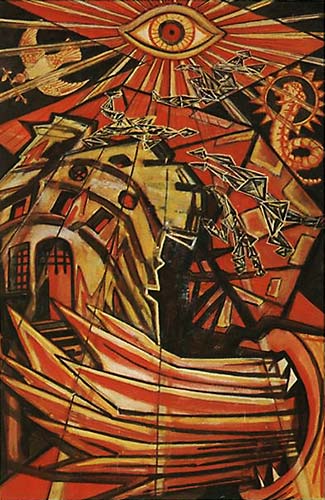
Mars
Quarrel, combat, danger, ruin, destruction of plans, sudden death, escape from prison.
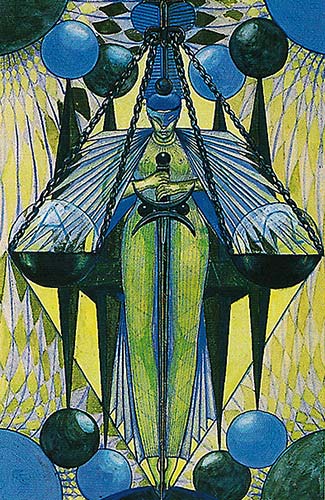
Libra
Justice, or rather justesse, the act of adjustment, suspension of all action pending decision; in material matters, may refer to law suits or prosecutions. Socially, marriage or marriage agreements; politically, treaties.
Your Current Path
cards represent your current path as it would unfold naturally. These cards are read in chronological order from left to right.
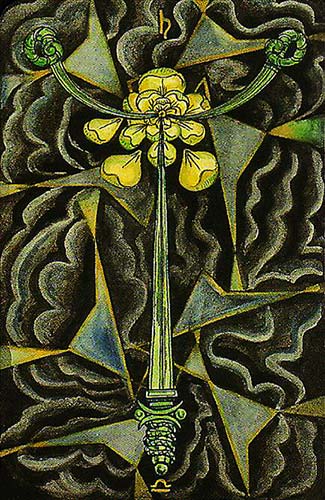
Saturn in Libra – Sorrow
This card is dark and heavy; it is, so to speak, the womb of Chaos. There is an intense lurking passion to create, but its children are monsters. This may mean the supreme transcendence of the natural order. Secrecy is here, and Perversion.
The symbol represents the great Sword of the Magician, point uppermost; it cuts the junction of two short curved swords. The impact has destroyed the rose. In the background, storm broods under implacable night.

Moon in Taurus – Success
The Number Six, Tiphareth, as before, represents the full harmonious establishment of the Energy of the Element. The Moon in Taurus rules the card; and this, while increasing the approach to perfection (for the Moon is exalted in Taurus and therefore in her highest form) marks that the condition is transient.
The disks are arranged in the form of the Hexagram, which is shown in skeleton. In the centre blushes and glows the light rose- madder of dawn, and without are three concentric circles, golden yellow, salmon-pink, and amber. These colours show Tiphareth fully realised on Earth; it reaffirms in form what was mathematically set forth in describing the Ace. The planets are arranged in accordance with their usual attribution; but they are only shown as disks irradiated by the Sun in their centre. This Sun is idolised as the Rose and Cross; the Rose has forty-nine petals, the interplay of the Seven with the Seven.
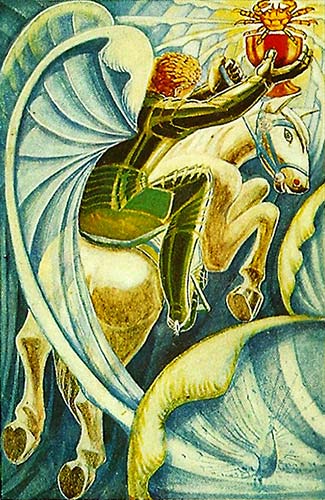
Pisces
The Knight of Cups represents the fiery part of Water, the swift passionate attack of rain and springs; more intimately, Water's power of solution. He is clothed in black armour furnished with bright wings which, together with the leaping attitude of his white charger, indicates that he represents the most active aspect of Water. In his right hand he bears a cup from which issues a crab, the cardinal sign of Water, for aggressiveness. His totem is the peacock, for one of the stigmata of water in its most active form is brilliance. There is here also some reference to the phenomena of fluorescence.
The characteristics of the person signified by this card are nevertheless mostly passive, in accordance with the Zodiacal attribution. He is graceful, dilettante, with the qualities of Venus, or a weak Jupiter. He is amiable in a passive way. He is quick to respond to attraction, and easily becomes enthusiastic under such stimulus; but he is not very enduring. He is exceedingly sensitive to external in fluence, but with no material depth in his character.
The Alternate Path
cards represent the alternate path that you could choose to take in lieu of the Current Path. However, if the cards that come up seem to indicate that they go along with the Current Path, these three cards should be interpretted not as an Alternate Path, but as a chronological extension of the Current Path (also read from left to right).
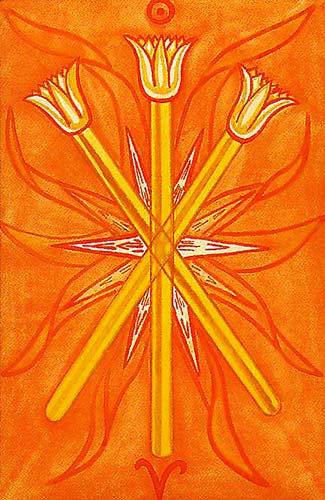
Sun in Aries – Virtue
This card refers to Binah in the suit of Fire, and so represents the establishment of primeval Energy. The Will has been trans mitted to the Mother, who conceives, prepares, and gives birth to, its manifestation. It refers to the Sun in Aries, the Sign in which he is exalted.
The meaning is harmonious, for this is the beginning of Spring. For this reason, one sees the wand taking the form of the Lotus in blossom. The Sun has enkindled the Great Mother.
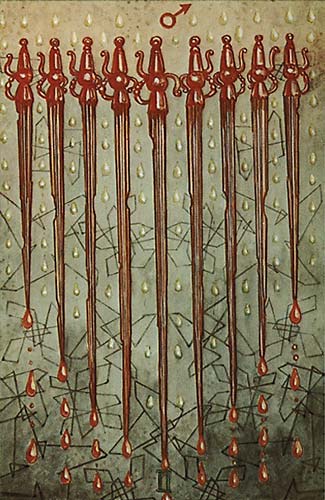
Mars in Gemini – Cruelty
Consciousness has fallen into a realm unenlightened by reason. This is the world of the unconscious primitive instincts, of the psychopath, of the fanatic. The celestial ruler is Mars in Gemini, crude rage of hunger operating without restraint; although its form is intellectual, it is the temper of the inquisitor.
The symbol shows nine swords of varying lengths, all striking downwards to a point. They are jagged and rusty. Poison and blood drip from their blades. There is, however, a way of dealing with this card: the way of passive resistance, resignation, the acceptance of martyrdom. Nor is an alien formula that of implacable revenge.

Moon in Libra – Peace
The Moon is change, but Nature is peaceful; moreover, Libra represents balance; between them, they regulate the energy of the Swords.
In the card appear two swords crossed; they are united by a blue rose with five petals. This rose represents the influence of the Mother, whose harmonising influence compounds the latent antagonism native to the suit. The Rose emits white rays, producing a geometrical pattern that emphasises the equilibrium of the symbol.
The Psychological Basis
cards shed light upon the psychological undertones of the current problem.

Pisces
Illusion, deception, bewilderment, hysteria, even madness, dreaminess, falsehood, error, crisis, 'the darkest hour before the dawn', the brink of important change.

The Princess of Swords represents the earthy part of Air, the fixation of the volatile. She brings about the materialisation of Idea. She represents the influence of Heaven upon Earth. She represents to some extent the anger of the Gods, and she appears helmed, with serpent-haired Medusa for her crest. She stands in front of a barren altar as if to avenge its profanation, and she stabs downward with her sword. The heaven and the clouds, which are her home, seem angry.
The character of the Princess is stern and revengeful. Her logic is destructive. She is firm and aggressive, with great practical wisdom and subtlety in material things. She shews great cleverness and dexterity in the management of practical affairs, especially where they are of a controversial nature. She is very adroit in the settlement of controversies.
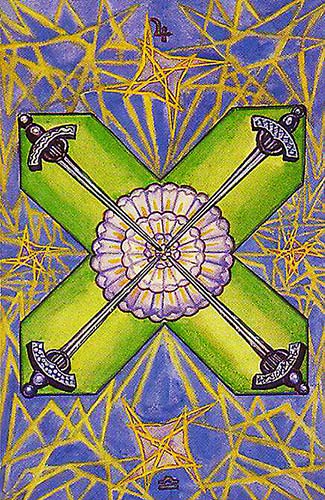
Jupiter in Libra – Truce
Chesed refers to Jupiter who rules in Libra in this decanate. The sum of these symbols is therefore without opposition; hence the card proclaims the idea of authority in the intellectual world. It is the establishment of dogma, and law concerning it. It represents a refuge from mental chaos, chosen in an arbitrary manner. It argues for convention.
The hilts of the four Swords are at the corner of a St. Andrew's cross. Their shape suggests fixation and rigidity. Their points are sheathed – in a rather large rose of forty-nine petals representing social harmony. Here, too, is compromise.
Minds too indolent or too cowardly to think out their own problems hail joyfully this policy of appeasement. As always, the Four is the term; as in this case there is no true justification for repose, its disturbance by the Five holds no promise of advance; its static shams go pell-mell into the melting-pot; the issue is mere mess, usually signalised by foetid stench. But it has to be done!
Karma
These cards represent the influences of karma and destiny that are beyond your control. They suggest adapting to this fate.

The Root of Water
This card represents the element of Water in its most secret and original form. It is the feminine complement of the Ace of Wands, and is derived from the Yoni and the Moon exactly as that is from the Lingam and the Sun. The third in the Hierarchy. This accordingly represents the essential form of the Holy Grail. Upon the dark sea of Binah, the Great Mother, are Lotuses, two in one, which fill the cup with the Life-fluid, symbolically represented either as Water, as Blood, or as Wine, according to the selected purpose of the symbolism.
Above the Cup, descending upon it, is the Dove of the Holy Ghost, thus consecrating the element. At the base of the Cup is the Moon, for it is the virtue of this card to conceive and to produce the second form of its Nature.
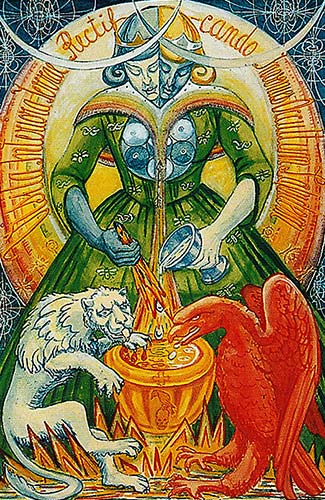
Sagittarius
Combination of forces, realisation, action based on accurate calculation; the way of escape, success after elaborate manoeuvres.
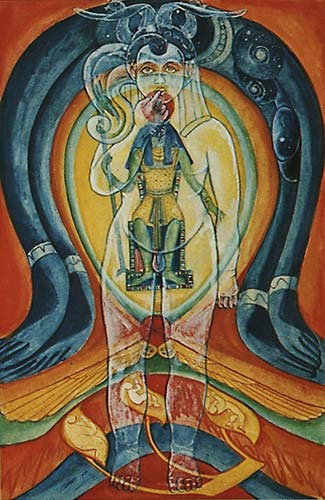
Fire
Final decision in respect of the past, new current in respect of the future; always represents the taking of a definite step.